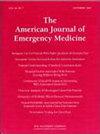Diagnostic yield of 24 to 48-hour ambulatory cardiac monitoring in discharged emergency department patients
IF 2.7
3区 医学
Q1 EMERGENCY MEDICINE
引用次数: 0
Abstract
Objective
To evaluate the diagnostic yield of Holter monitoring at Emergency Department (ED) discharge.
Methods
A retrospective chart review was performed of all patients discharged from the Mayo Clinic Emergency Department with a 3- or 12‑lead, 24- or 48-h Holter monitor from January 2, 2017 through April 30, 2018. Each case was assigned into one of four diagnostic classifications: symptomatic, negative Holter; silent arrhythmia; symptomatic arrythmia; or no symptoms, negative Holter.
Results
491 patients were included in this study. The most common presenting chief complaints were palpitations (31.4 %), syncope (11.8 %), chest pain (8.8 %) and lightheadedness (8.4 %). Overall diagnostic yield for ED Holter monitoring was 68.2 % (CI: 63.9–72.3), which included results that would impact either diagnosis, management, and/or follow-up. There was no difference in diagnostic yield between the 24- and 48-h monitoring durations (66.9 % vs 70.7 %, respectively; p = 0.39). Patients aged 61–95 years were most likely to have a diagnostic monitor at 77.6 % (n = 152/196; CI: 71.1–83.2). A total of 50.5 % (n = 248/491) patients reported symptoms during their monitoring period. Significant arrhythmias were detected in 37.3 %, (n = 183/491) of patients. There were no patient deaths during or within 30 days after use.
Conclusions
The practice of discharging low risk ED patients with a Holter monitor has high diagnostic utility and is safe. Holter monitors allow for continuation of the diagnostic evaluation of patients presenting to the ED with symptoms potentially concerning for cardiac arrythmia deemed safe for discharge.
求助全文
约1分钟内获得全文
求助全文
来源期刊
CiteScore
6.00
自引率
5.60%
发文量
730
审稿时长
42 days
期刊介绍:
A distinctive blend of practicality and scholarliness makes the American Journal of Emergency Medicine a key source for information on emergency medical care. Covering all activities concerned with emergency medicine, it is the journal to turn to for information to help increase the ability to understand, recognize and treat emergency conditions. Issues contain clinical articles, case reports, review articles, editorials, international notes, book reviews and more.

 求助内容:
求助内容: 应助结果提醒方式:
应助结果提醒方式:


